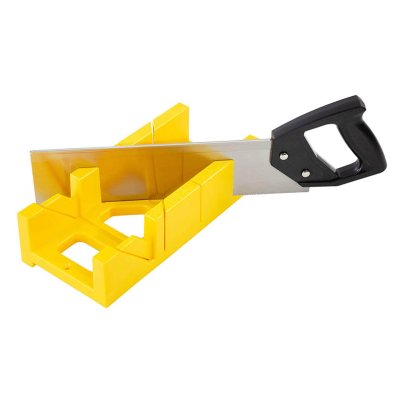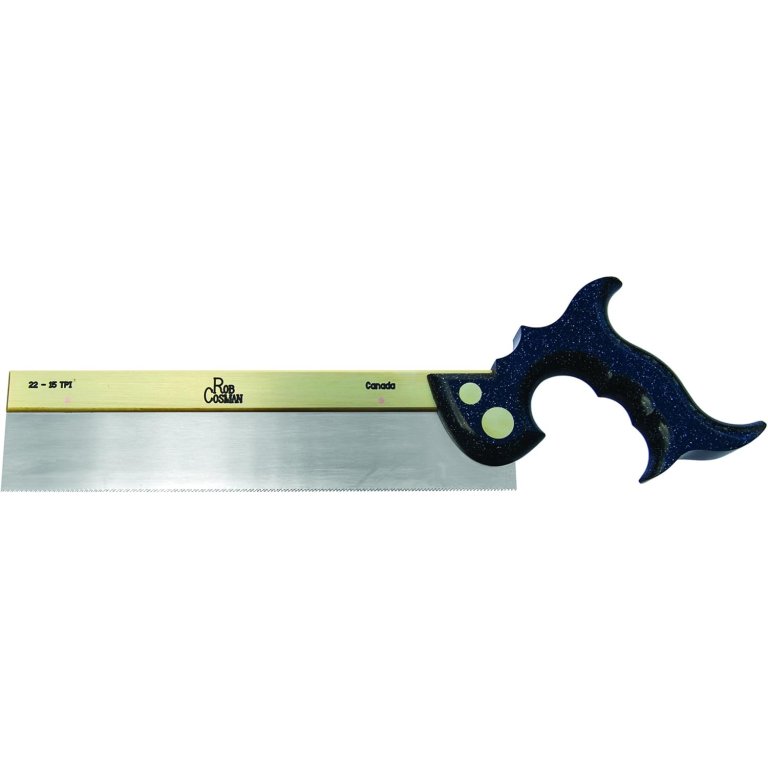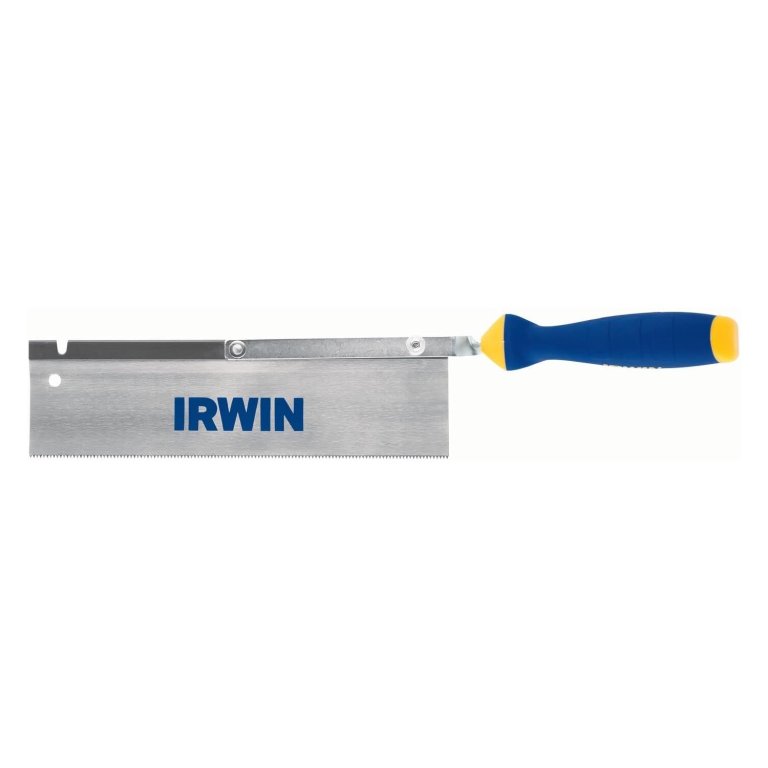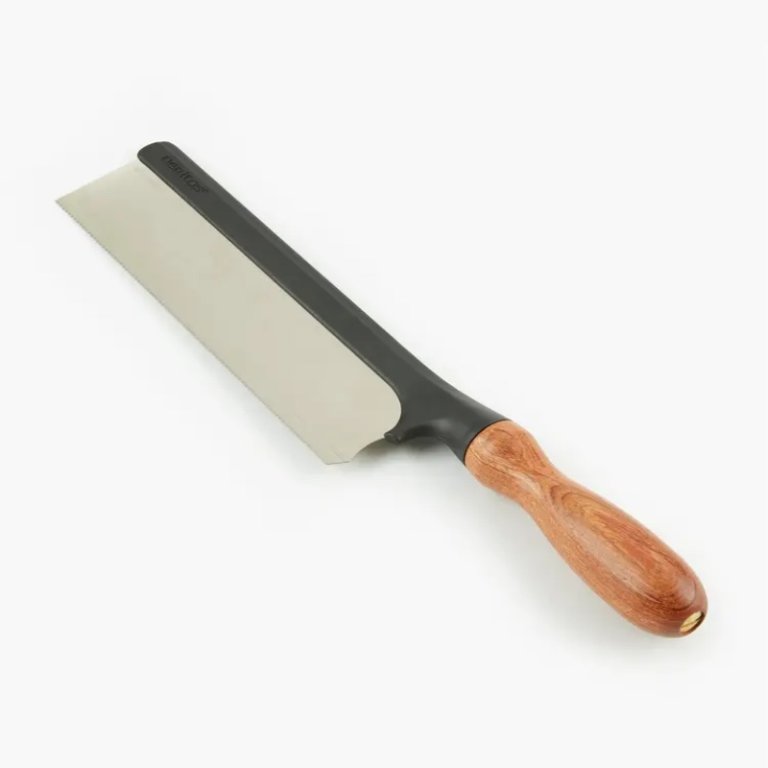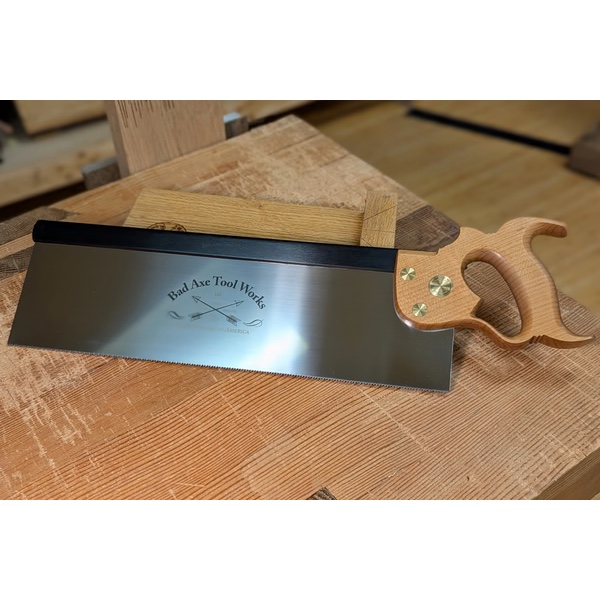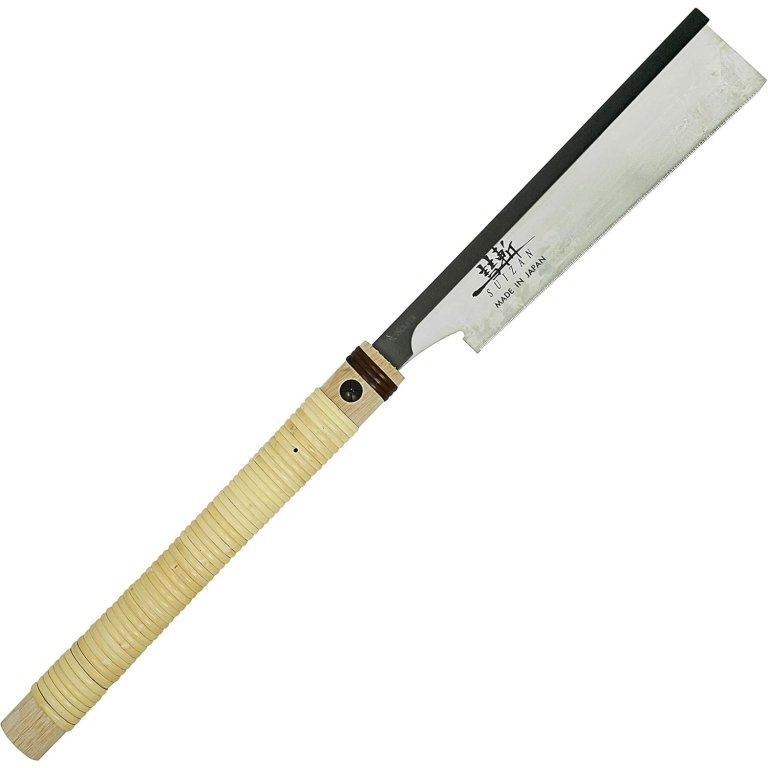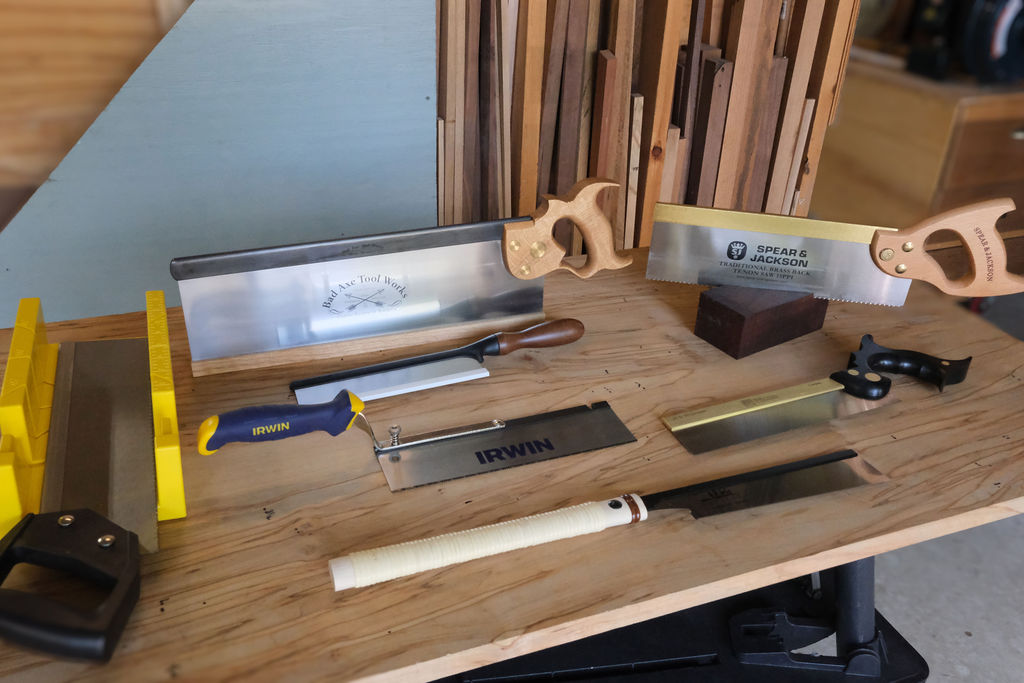
We may earn revenue from the products available on this page and participate in affiliate programs. Learn More ›
Although a back saw may not be considered an essential woodworking tool, it should by no means be viewed as a luxury item. The fact that this tool has changed so little in hundreds of years is a testament to its efficiency at jobs like sawing across the grain or for making clean, accurate cuts like dovetails, tenons, and shoulder joints. But not all back saws perform the same, and details set a saw apart, such as plate thickness, pitch (tooth spacing), rake (angle of saw teeth), weight, and length. That’s why we tested different types of saws across price points and styles to find out which ones lead the pack and how well they cut.
By their nature, back saws are among the safest wood-cutting tools. This is largely due to their design: back saws feature a rigid spine that prevents the blade from flexing and helps maintain straight, controlled cuts. This rigidity makes them easier to handle, especially for beginners. The small size of dovetail and gent’s saws are particularly well-suited for introducing children to woodworking. These saws typically have fine teeth, which result in smoother, cleaner cuts that are less likely to catch or bind in the wood.
Our top recommendation? The Rob Cosman Dovetail Back Saw. Designed by a master craftsman with decades of teaching experience, this saw features a two-stage pitch for easier and smoother start cuts and a fast finish. The Rob Cosman saw is especially well-suited for those serious about hand-cut joinery, offering an aggressive yet controllable cut and unmatched start-ability right out of the box. It feels good in the hand, and its weight is enough to carry it through the cut on its own. In particular, this saw is definitely worth trying for those who have difficulty beginning their cuts.
This guide breaks down the different types of back saws and helps the dedicated woodworker choose the right one for their specific needs. Read on to explore the key factors to consider when selecting a back saw, followed by a look at some of the best-rated options available today.
- BEST OVERALL: Rob Cosman Dovetail Back Saw
↓ Jump to Review - BEST BANG FOR THE BUCK: GreatNeck 12-Inch Mitre Box With 14-Inch Back Saw
↓ Jump to Review - BEST DOVETAIL SAW: Irwin 10-Inch ProTouch Dovetail Cut and Jamb Saw
↓ Jump to Review - BEST GENT’S SAW: Veritas Gent’s Saws
↓ Jump to Review - BEST TENON SAW: Spear & Jackson 12-Inch Traditional Tenon Saw
↓ Jump to Review - BEST HYBRID SAW: Bad Axe 16-Inch Tenon Saw
↓ Jump to Review - BEST JAPANESE STYLE: Suizan 8-Inch Dozuki Dovetail Blade Pull Saw
↓ Jump to Review

Back Saws Comparison Chart
| Product | Blade material | Teeth per inch | Cut depth |
| Rob Cosman Dovetail Back Saw | Spring steel | 22, then 15 | 1 5/8 inches |
| GreatNeck 12-Inch Mitre Box With 14-Inch Back Saw | Stainless steel | 12 | 3 inches b |
| Irwin 10-Inch ProTouch Dovetail Cut and Jamb Saw | High speed steel | 14 | 2 inches |
| Veritas Gent’s Saws | High-carbon steel | 20 | 1 5/8 inches |
| Spear & Jackson 12-Inch Traditional Tenon Saw | High-carbon steel | 15 | 2 1/2 inches |
| Bad Axe 16-Inch Tenon Saw | Swedish spring steel plate | 12 | 4 inches |
| Suizan 8-Inch Dozuki Dovetail Blade Pull Saw | Japanese steel | 30 | 1 1/2 inches |
Our Top Picks
Now that you’ve read about the sizes and specifications associated with these tools, it’s time to focus on several high-quality models currently on the market in specific categories. Read on to discover some of the best back saws to add precision to your next woodworking project.
Best Overall
Photo: AmazonWhat We Like
- Narrow set results in straight tracking, minimal kerf
- Ergonomic pistol grip handle with carved finger recesses
- Thick brass back adds weight and stability
- Saw starts with ease and cuts steadily fast
What We Don’t Like
- More expensive than other dovetails saws
Product Specs
- Blade material Spring steel
- Teeth per inch 22 tpi, 15 tpi
- Cut depth 1 5/8 inches
Our Ratings
| Cut Quality | 5/5 | Build Quality | 5/5 | Ergonomics | 5/5 | Value | 5/5 |
The Rob Cosman dovetail saw is a premium tool that performs exceptionally well right out of the box, living up to its reputation among serious woodworkers. Its standout feature is the innovative two-stage tooth pitch, which combines the easy-start feature of a fine-tooth saw with more coarse teeth for a quick, clean cut. The first two inches of the blade are outfitted with fine teeth—22 teeth per inch (TPI)—with a negative rake angle. This section allows for a smooth, chatter-free start, especially helpful for placing the saw exactly where desired and beginning the cut confidently.
After the initial start, the saw transitions to coarser teeth—15 TPI with a more aggressive rake angle—which cuts quickly into the wood, speeding up the cut without sacrificing control. The teeth are rip-filed, perfect for dovetails and other fine joinery tasks, and the minimal set of just .002 inch per side keeps the kerf narrow and the tracking straight. Even novice woodworkers will appreciate how effortlessly this saw delivers accurate, clean results.
What truly sold us on this saw was the fine-tooth toe. That clever design detail, combined with razor-sharp teeth and superb craftsmanship, makes the saw a joy to use. It cuts through hardwood like butter, with a comfortable weight and excellent balance in hand. Yes, it’s a high-end tool, but the precision, quality, design, and weight make it worth every penny. For anyone serious about dovetailing, this saw is a game-changer.
What our tester says: “I’ve tried other premium dovetail saws, but Rob Cosman’s saw is the only one that feels like it was made to work with me.The fine starter teeth make beginning a cut effortless—no jumping or skittering at all. The weight from the brass back gives it a natural downward momentum that helps it track straight.”—Cathy Harms, Product Reviews tester and writer
Get the Rob Cosman back saw at Woodcraft or Rob Cosman.
Best Bang for the Buck
GreatNeck 12-Inch Mitre Box With 14-Inch Back Saw
Buy at AmazonWhat We Like
- Budget-friendly choice for the hobbyist
- Great for smaller projects and trim work
- Miter box features presets for 45- and 90-degree cuts
- Easily portable with 8.5-inch ruler edge
What We Don’t Like
- Saw struggles with hardwoods
- Plastic handle may not hold up
Product Specs
- Blade material Stainless steel
- Teeth per inch 12
- Cut depth 3 inches
Our Ratings
| Cut Quality | 4/5 | Build Quality | 4.5/5 | Ergonomics | 4.5/5 | Value | 5/5 |
A back saw is commonly used to cut precise 45- or 90-degree joints in lumber, so it’s especially useful for trim, molding, and small woodworking projects. Many models, like the GreatNeck reinforced steel back saw, come paired with a miter box to make angled cuts quick and consistent. The saw fits into preset slots, guiding each cut with minimal guesswork. It can also be used freehand, offering flexibility beyond the miter box.
The GreatNeck back saw features a 14-inch blade with 12 TPI, suitable for softwoods, quarter-round trim, and crown molding. While not the sharpest blade available, it cuts cleanly across grain in soft materials. The reinforced spine helps keep cuts straight, and the plastic handle offers a decent grip.
The included miter box allows for cuts up to three inches deep. For added stability, a useful modification is to screw the miter box to a scrap board and clamp the whole setup to a sawhorse. This creates a much sturdier and safer workstation—especially helpful when working with longer stock or repetitive cuts.
Though this small handheld saw may not satisfy the needs of fine woodworkers or professionals seeking high-precision results, this saw and miter box combo is a great value for DIYers. For tasks like framing, trim work, or rustic furniture builds, it’s a solid, budget-friendly solution that gets the job done efficiently.
Get the Great Neck mitre box and back saw at Amazon.
Best Dovetail Saw
Irwin 10-Inch ProTouch Dovetail Cut and Jamb Saw
Buy at Lowe'sWhat We Like
- Reversible blade enables cuts from either direction
- Flush cut blade trims door jambs and millwork
- Affordable price point
- Flexible blade for flush cuts without gouging flooring
What We Don’t Like
- With 14 TPI, it may produce rougher cuts
- Steel teeth wear down faster on hardwoods and MDF
Product Specs
- Blade material High speed steel
- Teeth per inch 14
- Cut depth 2 inches
Our Ratings
| Cut Quality | 4/5 | Build Quality | 4.3/5 | Ergonomics | 4/5 | Value | 4.8/5 |
The Irwin dovetail cut and jamb saw is a specialized saw that’s built with one job in mind: flush cutting door jambs and trim when installing new flooring. For that purpose, it performs well, especially considering its affordable price. The reversible blade is a standout feature, allowing cuts from either direction simply by flipping the handle. This makes it convenient for working in tight corners or against walls.
That said, it’s not without its quirks. The blade has a tendency to bind or get stuck during a cut, especially if it isn’t perfectly flat. However, with smooth, controlled strokes and some patience, it gets the job done. It’s the kind of tool most homeowners will use occasionally, and for that limited use, the low price point makes it a worthwhile investment.
Where this saw falters is in versatility. Though it’s marketed as a dovetail saw as well, the offset handle is a design meant to aid in flush cutting, which throws off the alignment needed for precision dovetails. Additionally, the spring-loaded blade reversal mechanism, while clever, introduces some flex or “wander” in the blade, especially noticeable during fine woodworking tasks.
The Irwin dovetail cut and jamb saw is a great budget-friendly solution for door jamb trimming. Just don’t expect it to double as a precision joinery tool. For flooring DIYers, it’s worth having on hand. For dovetails, a true back saw is a better option.
Get the Irwin ProTouch back saw at Lowe’s.
Best Gent’s Saw
Photo: LeeValleyWhat We Like
- Fine, accurate cuts at 20 and 22 TPI
- High-carbon steel blade holds its edge
- Straight, rounded handle in line with saw’s spine
What We Don’t Like
- Extremely fine tooth pitch makes sharpening difficult
- Small size limits use
Product Specs
- Blade material High carbon steel
- Teeth per inch 20 (rip saw), 22 (crosscut)
- Cut depth 1 5/8 inches
Our Ratings
| Cut Quality | 4.8/5 | Build Quality | 4.8/5 | Ergonomics | 4/5 | Value | 4.7/5 |
The Veritas Gent’s Saw is a small dovetail saw with a straight, turned handle built for small-scale woodworking. It’s not an everyday dovetail saw—but when working with tiny parts, box making, or delicate joints, this saw shines. The high-carbon steel blade is just .015″ thick with a fine .003-inch set per side, making it ideal for cuts in stock ⅜ inch thick or less.
Veritas molds the spine from glass- and stainless steel-filled resin right over the blade and handle stud. The result? Rock-solid rigidity and feather-light heft, a plus for detailed work as the saw is easy to maneuver in tight, small-scale work. The bubinga handle is beautiful and well-finished, secured with a brass nut that looks as good as it functions.
The handle: It’s a straight, turned gent’s handle—traditional, yes, but not exactly ergonomic. Those accustomed to pistol grips may find that this one feels like a downgrade. It can be tricky to maintain plumb and angle control on longer cuts, and after a few passes, it gets a bit awkward in the hand.
That said, this saw isn’t meant to be a daily driver. It’s a specialist’s tool—and when trimming tiny moldings or looking for safe, clean cuts on small stock, it absolutely delivers. Those who do fine work will be glad to have this in the shop, even if it’s not one for everyday use.
Get the Veritas Gents back saw at Lee Valley, Veritas, or Klingspor’s.
Best Tenon Saw
Spear & Jackson 12-Inch Traditional Tenon Saw
Buy at AmazonWhat We Like
- Hybrid tooth design for rip and crosscuts
- Smooth starting cut, good tracking, and minimal tear-out
- High-carbon steel blade holds a sharp edge well
- Folded solid brass back protects blade from deforming
What We Don’t Like
- Beech handle is narrow
- Proud brass nuts can be uncomfortable
Product Specs
- Teeth per inch High-carbon steel
- Teeth per inch 15
- Cut depth 2 1/2 inches
Our Ratings
| Cut Quality | 4.5/5 | Build Quality | 4.8/5 | Ergonomics | 4/5 | Value | 4.8/5 |
The Spear & Jackson 12-inch tenon saw brings nearly 200 years of toolmaking experience to the workbench, and it shows. This is a traditional back saw with a modern high-carbon steel blade paired with a rigid folded brass back that gives it both strength and sharpness. With a 12-inch blade, 15 TPI, and a hybrid tooth pattern, this saw cuts both rip (along the grain) and crosscuts (across the grain) with surprising ease.
Need to cut a tenon cheek or shoulder? This saw starts clean, tracks true, and leaves a smooth finish with minimal tear-out. The offset teeth clear waste efficiently, and the solid brass spine keeps the blade from flexing when things get tough.
The handle is a mixed bag. The beech is solid and secured with three rivets—not the usual two—but it’s a bit too slim for comfort. That said, there’s enough material so users can reshape the handle to suit their hands and aesthetics.
There’s a little play in the blade under heavy pressure, and the proud brass nuts might snag the user’s palm, but these are minor gripes about a serious, well-balanced saw that feels at home in real joinery work.
Bottom line: For those who want a back saw that punches above its price, rips and crosscuts clean, and has room to grow with the user, the Spear & Jackson tenon saw delivers. This tenon saw is something of an investment, but it’s a fine tool that should last a lifetime.
Get the Spear and Jackson tenon back saw at Amazon.
Best Hybrid Saw
Bad Axe 16-inch Tenon Saw
Buy at Bad Axe Tool WorksWhat We Like
- Hybrid tooth pattern cuts tenon cheeks and shoulders
- Shallow kerf tracks tighter to the blade for straighter cuts
- Folded back allows for re-tensioning
- Superb build quality
- Saw blade stays straight and centered in the kerf
What We Don’t Like
- Tenon saw grabbed at the wood
- Premium price compared to other tenon saws
Product Specs
- Blade material Swedish spring steel
- Teeth per inch 12
- Cut depth 4 inches
Our Ratings
| Cut Quality | 5/5 | Build Quality | 4.8/5 | Ergonomics | 5/5 | Value | 5/5 |
The Bad Axe 16-inch Tenon Saw feels right from the first cut, like it’s an extension of the arm. That’s thanks to Bad Axe’s attention to the hang angle—the angle of the tote in relation to the tooth line—which is perfectly dialed in. Push the saw forward and it drives itself straight with no compensating and no wandering. It bites into the wood and moves forward making clean cuts.
With a 12 TPI tooth line and precise hammer-set teeth, this saw tracks laser-straight. High end saws like Bad Axe go the extra mile with hammer setting the teeth instead of using pliers to bend the teeth—it’s about precision, control, and craftsmanship. There’s barely any kerf wiggle, so the blade hugs the line tight. Wax the blade up, and it glides like glass, making clean cuts on cheeks, shoulders, and even large dovetails.
A pro trick: Use the mirror-like reflection in the saw plate to keep the cut square. When the reflection of the workpiece lines up straight, it’s level.
The build is equally dialed in. A folded black-oxidized carbon steel back adds stiffness and can be removed to re-tension the blade if needed. The quartersawn white oak handle (modeled after the classic 1887 Disston grip) is more refined and feels sculpted to the hand while the flush-set brass nuts provide a better fit and finish.
This saw’s not just pretty—it’s tough, built to tackle big joinery jobs but precise enough for detailed dovetails. Buyers can even customize the tooth set, grip size, and materials. Plus, it includes a lifetime warranty.
Those looking for a tenon saw that cuts like a dream, feels rock-solid, and makes every other saw on the rack jealous will find that the Bad Axe 16-inch tenon saw delivers.
What our tester says: “After using the Bad Axe Tenon Saw for several weeks on a large joinery project, I can confidently say it’s a powerhouse in my shop. The saw starts cleanly with zero chatter, and the weight of the saw feels perfectly balanced. It tracks dead straight through tenon cheeks and shoulders, leaving smooth surfaces.”—Cathy Harms, Product Reviews tester and writer
Get the Bad Axe tenon back saw at Bad Axe Tool Works.
Best Japanese Style
Suizan 8-Inch Dozuki Dovetail Blade Pull Saw
Buy at AmazonWhat We Like
- Thin, high-precision blade ideal for fine joinery
- Cuts on the pull stroke
- Comfortable, lightweight rattan-wrapped handle
- Replaceable blade
- Excellent value for the quality
What We Don’t Like
- Fragile blade prone to bending or snapping
Product Specs
- Blade material Japanese steel
- Teeth per inch 30
- Cut depth 1 1/2 inches
Our Ratings
| Cut Quality | 5/5 | Build Quality | 4.8/5 | Ergonomics | 5/5 | Value | 5/5 |
The Suizan Dozuki Japanese pull saw is an excellent choice for woodworkers transitioning from western-style saws, cutting on the pull rather than the push. Like a western tenon saw, the Dozuki features a reinforced spine that limits flex and keeps the blade rigid during use. This spine makes the saw less ideal for tight spaces, but the payoff is a blade that tracks straight with minimal wandering—perfect for precise joinery cuts.
The 0.012-inch blade leaves a super narrow kerf of only 0.02 inch.The blade cuts on the pull stroke and excels at delivering precise crosscuts. The rattan-wrapped straight handle provides clear blade orientation for better control.
Cutting on the pull stroke rather than the push (as in Western saws), the Dozuki offers excellent control with less effort. This makes it easier for newcomers to adjust to the feel of a Japanese saw. The blade is made from premium Japanese steel, a material known for its high hardness and durability. While not naturally corrosion-resistant, the steel performs exceptionally well when properly maintained.
Overall, the Suizan Dozuki is a precise, lightweight tool ideal for fine woodworking. Its reinforced spine, comfortable grip, and superior blade material make it a solid addition to any shop, especially for those making the switch from Western to Japanese-style saws.
Get the Suizan 8-inch Dozuki Pull back saw at Amazon.
Jump to Our Top Picks

How We Tested the Best Back Saws
| Products tested | Over a dozen tested, seven made the list |
| Time spent testing | 3 weeks |
| Tests performed | Four |
| Price range | $20-345 |
To determine the top performers in our handsaw roundup, we evaluated over a dozen saws from both boutique makers and mass-market brands. We considered key features like price, tooth geometry, cutting performance, weight, ergonomics. Each saw was tested in real-world joinery scenarios, with a focus on hybrid saws suitable for both rip and crosscutting.
Testing followed a structured series of tasks. To assess rip performance, we cut tenon cheeks along the grain, judging ease of starting, smoothness, and tracking accuracy. For crosscut ability, we used a marking gauge to scribe tenon shoulders and tracked how well each saw followed the line across the grain, noting tear-out and kerf quality in both hardwood and softwood. Each saw also underwent repeated start-stop cuts to evaluate tooth behavior and entry control. Finally, we examined kerf thickness and tracking precision by cutting to a line to test how the saw tracks a straight line.
| Product | Cut Quality | Build Quality | Ergonomics | Value |
| Rob Cosman Dovetail Back Saw | 5/5 | 5/5 | 5/5 | 5/5 |
| GreatNeck 12-Inch Mitre Box With 14-Inch Back Saw | 4/5 | 4.5/5 | 4/5 | 5/5 |
| Irwin 10-Inch ProTouch Dovetail/Jamb Saw | 4/5 | 4.3/5 | 4/5 | 4.8/5 |
| Veritas Gent’s Saws | 4.8/5 | 4.8/5 | 4/5 | 4.7 |
| Spear & Jackson 12-Inch Traditional Tenon Saw | 4.5/5 | 4.8/5 | 4/5 | 4.8/5 |
| Bad Axe 16-Inch Tenon Saw | 5/5 | 4.8/5 | 5/5 | 5/5 |
| Suizan 8-Inch Dozuki Dovetail Blade Pull Saw | 5/5 | 4.8/5 | 5/5 | 5/5 |
What to Consider When Choosing a Back Saw

The definition of a back saw includes any saw with a reinforced brass or steel back edge. This design is to prevent blade flex and therefore aids in consistent, accurate cutting. Considered essential woodworking saws, back saws fall into several categories and include different features. The following section looks at technical differences among these tools and should help refine your search for the best back saw for a particular task.
Type
Although any saw with a strengthened spine can be called a back saw, these tools are divided into different types of wood cutting saws.
The tenon saw is the largest of these sawing tools, although it is often simply referred to as a back saw in the United States. It is a general-purpose saw named for cutting the tenon of a mortise and tenon joint and also for sawing across the grain and cutting miters. In fact, manufacturers often sell a tenon saw with a miter box. This tool is usually found on the job site, as well as in a workshop.
A dovetail saw is somewhat smaller. As the name suggests, it is commonly used to cut dovetail joints, though many dovetail saws are still large enough to provide good versatility. The gentleman’s saw (usually just called a gent’s saw) is a smaller, more refined tool for detailed shop work.
Teeth
A back saw usually has a crosscut tooth pattern rather than the rip tooth pattern on larger general purpose carpentry saws. The teeth point straight up instead of being angled in the direction of the cut, making for cleaner cuts across or at an angle to the grain. Teeth may simply be stamped out of the blade material, though they are often induction hardened using an electrical current to retain their sharpness longer.
The number of teeth per inch (TPI) determines the smoothness of the cut, but it also affects the speed at which the saw cuts. Fewer larger teeth are faster than more smaller teeth. A general-purpose back saw might have 12 or 13 TPI, whereas, at the other end of the scale, a gent’s saw could have 18 to 20 TPI.
Blade Size and Material
As might be expected, a general-purpose back saw is a much larger tool than a gent’s saw. The blade on a tenon saw can be up to 18 inches in length, though 12 to 14 inches is more common. A dovetail saw will typically be 8 to 10 inches, and a gent’s saw is usually 6 to 8 inches long.
Blades also tend to be proportionally shallower as they grow shorter. For example, a tenon saw appears quite stocky, but a gent’s saw looks rather delicate. This is because the former may have to withstand considerable force while sawing, so it needs plenty of material in the blade. In contrast, the latter is only for fine work, so the support offered by the reinforced back is sufficient.
The depth of the blade is also a factor when choosing the best back saw for your needs. Keep in mind that the depth is, in effect, the maximum depth of cut because the back will prevent you from sawing any deeper.
Blades are invariably made of steel. Quality varies, but accurate information about type is not always available. In general, high carbon steel blades are of higher quality, which is often reflected in the price. The reinforcing strip along the back is traditionally brass, though steel is also used in the construction. While the latter may be less visually attractive, it is stronger.
Handle
A back saw can feature one of two types of handles. Tenon saws tend to use the standard pistol grip, which provides a secure hold when sawing larger sections of material. Some are flat; others are contoured to maximize the grip. Dovetail and gent’s saws generally have an inline handle and don’t require a lot of physical power behind them to operate.
Handle materials vary considerably. Wood is the traditional and preferred choice on dovetail and gent’s saws. Low-cost tenon saws often have plain plastic handles, which can best be described as functional. More high-quality tools boast composite handles, which offer both durability and comfort.

FAQs
Having read through our considerations and taken a close look at some of the top-rated options, you’re now in a much better position to choose the best back saw for your needs. That said, you may have questions that are as yet unanswered. The following section covers many of the most frequently asked queries.
In general, a back saw is a woodworking tool, though you could occasionally use it to cut soft metals like aluminum, brass, or copper. If you need to cut metal regularly, especially steel, you should buy a hacksaw.
If you frequently use a back saw, it is likely to need sharpening eventually. Fortunately, doing so isn’t particularly difficult but does take some practice. For practical help, you can refer to our guide to sharpening saw blades. Back saws with induction hardened teeth cannot be sharpened as they’re too hard. However, they do last much longer than blades with stamped teeth.
According to veteran woodworker William Burton, “rip teeth are easier to sharpen than crosscut teeth, but a good woodworker should be able to sharpen both types of teeth.” He adds, “Find a couple cheap old saws at a yard sale and practice sharpening them.” The exception is the Japanese style saw. Many of those have a replaceable blade that snaps into the frame.
Keeping a back saw in peak condition is relatively easy. Giving the blade an occasional wipe with paste wax will help prevent rust. Light machine oil also works, but it might transfer to workpieces. If practical, give the back saw its own storage area so the teeth don’t bang against other tools. If the saw has a wooden handle, as many do, keep it as dry as possible and occasionally wax it.
A back saw should last at least several years, even with heavy use. Some of the best dovetail and gent’s saws can be considered “heirloom” tools. With a bit of care, they can last a lifetime.
A back saw is one of the most accurate saws in a shop, thanks to its stiffened spine along the back of the blade. Ideal for joinery, it requires little effort to control and tracks accurately, making it essential for precision work.
Clean a back saw by wiping the blade with a white non-scratching pad or fine steel wool with mineral spirits or blade cleaning solution to remove resin and grime. Then, lightly oil the blade with Camellia Oil to prevent future corrosion.
Hang saws by their handles to prevent blade damage. Use a saw till to store saws vertically, supporting handles and blades. Add a blade guard to protect the cutting edge.
Meet the Tester
Cathy Harms is an award-winning woodworker, teaching artist, and writer covering a range of topics including woodworking, home improvement, tool selection, DIY and home decor for a variety of publications. Her work has been featured in Fine Woodworking Magazine, and her educational toys were named “Etsy Finds.” Cathy owns Charms Woodworks, a one-woman woodworking shop where, for the past 15 years, she specializes in building furniture using fine joinery techniques and teaches toy making workshops. All her woodworking projects are made with true DIY spirit and dedication to the finer points of design, form and function.

